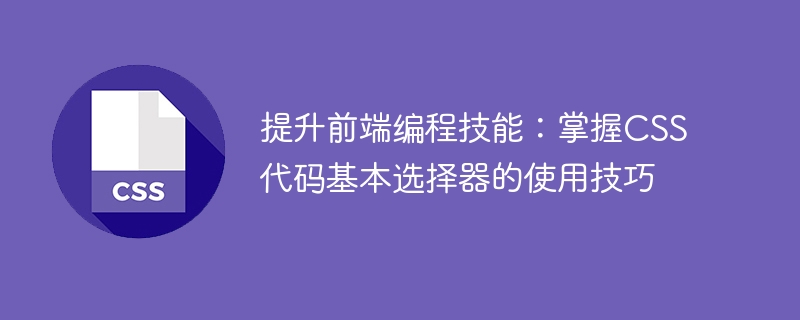

Improve front-end programming skills: Master the skills of using basic selectors in CSS code
In the modern Internet era, front-end development has become a hot skill. As a front-end developer, it is very important to master the basic skills of using CSS (Cascading Style Sheets) selectors because they are the basis for creating beautiful and powerful web pages.
CSS selectors are patterns used to select HTML elements. They allow us to select HTML elements in various ways, such as by the element's tag name, class name, ID, attributes, etc. Mastering the skills of using basic selectors will enable us to write CSS code more efficiently and make our web pages more browser-compatible and maintainable.
First, let's take a look at the most basic selector - the label selector. Tag selectors select HTML elements by their names. For example, if we want to select all paragraph elements, we can use the p selector. This will select all p elements in the HTML and apply styles to them.
Next, we can use the class selector to select elements with the same class name. Class selectors are prefixed with a dot (.) followed by the class name. For example, if we have HTML code like this:
, we can use the .highlight selector to select that element and apply styles to it. By using class selectors, we can easily apply the same style to different groups of elements of a web page.
Another common use of class selectors is to select multiple different class names. For example, if we want to select elements with class names highlight and important, we can use the .highlight.important selector.
In addition, there is a selector called the ID selector. It is prefixed with a pound sign (#) followed by the ID name. Similar to class selectors, ID selectors allow us to select elements with a specific ID. But unlike the class selector, the ID selector can only select one element because the ID should be unique throughout the entire HTML page.
In addition to tag, class and ID selectors, we can also use attribute selectors. Attribute selectors select elements by selecting elements with a specific attribute or attribute value. For example, we can use the [name="username"] selector to select all elements with a name attribute value of "username" and apply a style to them.
Finally, we can also combine multiple selectors to select elements based on more complex conditions. This is called a combination of selectors. For example, we can use the p.highlight selector to select all paragraph elements with the class name highlight.
In addition to the basic selectors introduced above, CSS also has many other advanced selectors, such as descendant selectors, child selectors, adjacent sibling selectors, etc. These advanced selectors allow us to select elements more precisely and achieve more complex style control.
When writing CSS code, it is very important to understand and be proficient in using basic selectors. They provide us with flexibility and extensibility, allowing us to easily select and control HTML elements. At the same time, mastering selectors can also improve the efficiency and accuracy of writing style sheets.
Therefore, if you want to improve your front-end programming skills, don’t neglect the learning and practice of basic CSS selectors. By mastering their use, you'll be better able to create stunning web pages and provide a better user experience for your users.
The above is the detailed content of Learn to use basic CSS selectors to enhance your front-end programming skills. For more information, please follow other related articles on the PHP Chinese website!




